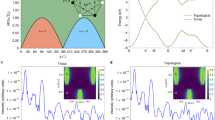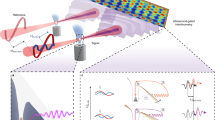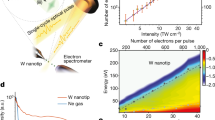Abstract
Coherent extreme-ultraviolet emission can be obtained through high-harmonic generation and multiphoton excitation from atoms exposed to a strong laser field. We report the generation of a new kind of coherent extreme-ultraviolet emission from He atoms excited by intense few-cycle laser pulses. An atom can be excited after tunnelling in a strong laser field, in the process known as frustrated tunnelling ionization (FTI). We find that excitation through FTI leads to coherent extreme-ultraviolet emission, and its intensity strongly depends on the ellipticity and carrier-envelope phase of the laser pulses. Additionally, the propagation direction of the emission can be coherently controlled by employing the attosecond lighthouse technique. This coherent control of tunnelling and recombination dynamics, which has provided the fundamental basis of attosecond physics, promises the utilization of FTI emission as a coherent light source and offers new opportunities in ultrafast spectroscopy.
This is a preview of subscription content, access via your institution
Access options
Access Nature and 54 other Nature Portfolio journals
Get Nature+, our best-value online-access subscription
$29.99 / 30 days
cancel any time
Subscribe to this journal
Receive 12 print issues and online access
$209.00 per year
only $17.42 per issue
Buy this article
- Purchase on Springer Link
- Instant access to full article PDF
Prices may be subject to local taxes which are calculated during checkout




Similar content being viewed by others
Data availability
The data that support the plots within this paper and other findings of this study are available from the corresponding author upon reasonable request.
References
Corkum, P. B. Plasma perspective on strong field multiphoton ionization. Phys. Rev. Lett. 71, 1994–1997 (1993).
Corkum, P. B. & Krausz, F. Attosecond science. Nat. Phys. 3, 381–387 (2007).
Krausz, F. & Ivanov, M. Attosecond physics. Rev. Mod. Phys. 81, 163–234 (2009).
Nubbemeyer, T., Gorling, K., Saenz, A., Eichmann, U. & Sandner, W. Strong-field tunneling without ionization. Phys. Rev. Lett. 101, 233001 (2008).
Eichmann, U., Nubbemeyer, T., Rottke, H. & Sandner, W. Acceleration of neutral atoms in strong short-pulse laser fields. Nature 461, 1261–1264 (2009).
Liu, H. et al. Low yield of near-zero-momentum electrons and partial atomic stabilization in strong-field tunneling ionization. Phys. Rev. Lett. 109, 093001 (2012).
Landsman, A. S. et al. Rydberg state creation by tunnel ionization. New J. Phys. 15, 013001 (2013).
Eichmann, U., Saenz, A., Eilzer, S., Nubbemeyer, T. & Sandner, W. Observing Rydberg atoms to survive intense laser fields. Phys. Rev. Lett. 110, 203002 (2013).
Xiong, W.-H., Xiao, X.-R., Peng, L.-Y. & Gong, Q. Correspondence of below-threshold high-order-harmonic generation and frustrated tunneling ionization. Phys. Rev. A 94, 013417 (2016).
Zimmermann, H., Patchkovskii, S., Ivanov, M. & Eichmann, U. Unified time and frequency picture of ultrafast atomic excitation in strong laser fields. Phys. Rev. Lett. 118, 013003 (2017).
Beaulieu, S. et al. Role of excited states in high-order harmonic generation. Phys. Rev. Lett. 117, 203001 (2016).
Bengtsson, S. et al. Space–time control of free induction decay in the extreme ultraviolet. Nat. Photon. 11, 252–258 (2017).
Beaulieu, S. et al. Phase-resolved two-dimensional spectroscopy of electronic wave packets by laser-induced XUV free induction decay. Phys. Rev. A 95, 041401 (2017).
Chini, M. et al. Coherent phase-matched VUV generation by field-controlled bound states. Nat. Photon. 8, 437–441 (2014).
Lewenstein, M., Balcou, P., Ivanov, M. Y., L'Huillier, A. & Corkum, P. B. Theory of high-harmonic generation by low-frequency laser fields. Phys. Rev. A 49, 2117–2132 (1994).
Brewer, C. A. et al. Single-shot extreme ultraviolet laser imaging of nanostructures with wavelength resolution. Opt. Lett. 33, 518–520 (2008).
Wagner, C. & Harned, N. EUV lithography: lithography gets extreme. Nat. Photon. 4, 24–26 (2010).
Itatani, J. et al. Tomographic imaging of molecular orbitals. Nature 432, 867–871 (2004).
Smirnova, O. et al. High harmonic interferometry of multi-electron dynamics in molecules. Nature 460, 972–977 (2009).
Wörner, H. J., Bertrand, J. B., Kartashov, D. V., Corkum, P. B. & Villeneuve, D. M. Following a chemical reaction using high-harmonic interferometry. Nature 466, 604–607 (2010).
Lewenstein, M., Salières, P. & L'Huillier, A. Phase of the atomic polarization in high-order harmonic generation. Phys. Rev. A 52, 4747–4754 (1995).
Chin, S. L. & Xu, H. Tunnel ionization, population trapping, filamentation and applications. J. Phys. B At. Mol. Opt. Phys. 49, 222003 (2016).
Salières, P., L’Huillier, A. & Lewenstein, M. Coherence control of high-order harmonics. Phys. Rev. Lett. 74, 3776–3779 (1995).
Boutu, W. et al. High-order-harmonic generation in gas with a flat-top laser beam. Phys. Rev. A 84, 063406 (2011).
Shchatsinin, I., Ritze, H.-H., Schulz, C. P. & Hertel, I. V. Multiphoton excitation and ionization by elliptically polarized, intense short laser pulses: recognizing multielectron dynamics and doorway states in C60 vs Xe. Phys. Rev. A 79, 053414 (2009).
Kim, K. T. et al. Photonic streaking of attosecond pulse trains. Nat. Photon. 7, 651–656 (2013).
Corsi, C., Pirri, A., Sali, E., Tortora, A. & Bellini, M. Direct interferometric measurement of the atomic dipole phase in high-order harmonic generation. Phys. Rev. Lett. 97, 023901 (2006).
Balogh, E. et al. Dynamic wavefront rotation in the attosecond lighthouse. Optica 4, 48–53 (2017).
Rundquist, A. et al. Phase-matched generation of coherent soft X-rays. Science 280, 1412–1415 (1998).
Kim, K. T. et al. Manipulation of quantum paths for space–time characterization of attosecond pulses. Nat. Phys. 9, 159–163 (2013).
Xu, L. et al. Route to phase control of ultrashort light pulses. Opt. Lett. 21, 2008–2010 (1996).
Sansone, G. et al. Isolated single-cycle attosecond pulses. Science 314, 443–446 (2006).
Larsson, J. et al. Two-colour time-resolved spectroscopy of helium using high-order harmonics. J. Phys. B At. Mol. Opt. Phys. 28, L53–L58 (1995).
Acknowledgements
This work was supported by the Institute for Basic Science grant (IBS-R012-D1).
Author information
Authors and Affiliations
Contributions
H.Y., J.H.M. and K.T.K. conceived and designed the experiment. H.Y., J.H.M., S.I.H. and S.B.P. performed the experiment. H.Y., J.H.M., I.A.I. and K.T.K. analysed the experimental data. H.Y., J.H.M., C.H.N. and K.T.K. wrote the manuscript.
Corresponding author
Ethics declarations
Competing interests
The authors declare no competing interests.
Additional information
Publisher’s note: Springer Nature remains neutral with regard to jurisdictional claims in published maps and institutional affiliations.
Supplementary information
Supplementary Information
Supplementary notes and figures.
Rights and permissions
About this article
Cite this article
Yun, H., Mun, J.H., Hwang, S.I. et al. Coherent extreme-ultraviolet emission generated through frustrated tunnelling ionization. Nature Photon 12, 620–624 (2018). https://doi.org/10.1038/s41566-018-0255-8
Received:
Accepted:
Published:
Issue Date:
DOI: https://doi.org/10.1038/s41566-018-0255-8
This article is cited by
-
Ultraviolet supercontinuum generation driven by ionic coherence in a strong laser field
Nature Communications (2022)



